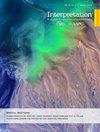Seismic spatially-variant noise suppression method in Tarim Basin based on FFDNet and Transfer Learning
IF 1.1
4区 地球科学
Q3 GEOCHEMISTRY & GEOPHYSICS
Interpretation-A Journal of Subsurface Characterization
Pub Date : 2023-01-10
DOI:10.1190/int-2022-0041.1
引用次数: 0
Abstract
Due to the complex geological structure and ultra-deep reservoir location, the noise distribution of prestack seismic data in the Tarim Basin is non-uniform. However, most of the current seismic random noise suppression methods lack the flexibility to deal with spatially-variant random noise. To address this issue, we propose an intelligent denoising method for seismic spatially-variant random noise and apply it in the Tarim Basin. On the basis of DnCNN, we add an extra channel to the input and introduce a tunable noise level map as input. The noise level map has the same dimensions as the input noisy seismic data, and each element in the noise level map corresponds to a denoising level. By adjusting the noise level map, a single model is able to handle noise with different levels as well as spatially-variant noise. Due to the lack of labeled field data in the Tarim Basin, we introduce a transfer learning scheme that transfers features of effective signals learned from synthetic data to the denoiser for field data. The network learns the general and invariant features of effective signal from a large number of easily obtained synthetic data and then learns the real effective signal characteristics from a small amount of approximately clean field data in the target area by fine-tuning. The processing results of synthetic and field data demonstrate that compared with f-x deconvolution, Dictionary Learning and DnCNN, the proposed method exhibits high effectiveness in suppressing spatially-variant random noise and preserves the effective signals better.基于FFDNet和迁移学习的塔里木盆地地震空间变噪声抑制方法
塔里木盆地地质结构复杂,储层位置超深,叠前地震资料噪声分布不均匀。然而,目前大多数地震随机噪声抑制方法缺乏处理空间变异随机噪声的灵活性。针对这一问题,我们提出了一种地震空间变异随机噪声的智能去噪方法,并将其应用于塔里木盆地。在DnCNN的基础上,我们在输入中添加了一个额外的通道,并引入了一个可调噪声水平图作为输入。噪声水平图具有与输入噪声地震数据相同的维度,并且噪声水平图中的每个元素对应于去噪水平。通过调整噪声水平图,单个模型能够处理不同水平的噪声以及空间变化的噪声。由于塔里木盆地缺乏标记的野外数据,我们引入了一种转移学习方案,将从合成数据中学习到的有效信号的特征转移到野外数据的去噪器中。该网络从大量容易获得的合成数据中学习有效信号的一般和不变特征,然后通过微调从目标区域中的少量近似干净的场数据中学习真正的有效信号特征。合成和现场数据的处理结果表明,与f-x反褶积、字典学习和DnCNN相比,该方法在抑制空间变异随机噪声方面表现出较高的有效性,并更好地保留了有效信号。
本文章由计算机程序翻译,如有差异,请以英文原文为准。
求助全文
约1分钟内获得全文
求助全文
来源期刊

Interpretation-A Journal of Subsurface Characterization
GEOCHEMISTRY & GEOPHYSICS-
CiteScore
2.50
自引率
8.30%
发文量
126
期刊介绍:
***Jointly published by the American Association of Petroleum Geologists (AAPG) and the Society of Exploration Geophysicists (SEG)***
Interpretation is a new, peer-reviewed journal for advancing the practice of subsurface interpretation.
 求助内容:
求助内容: 应助结果提醒方式:
应助结果提醒方式:


